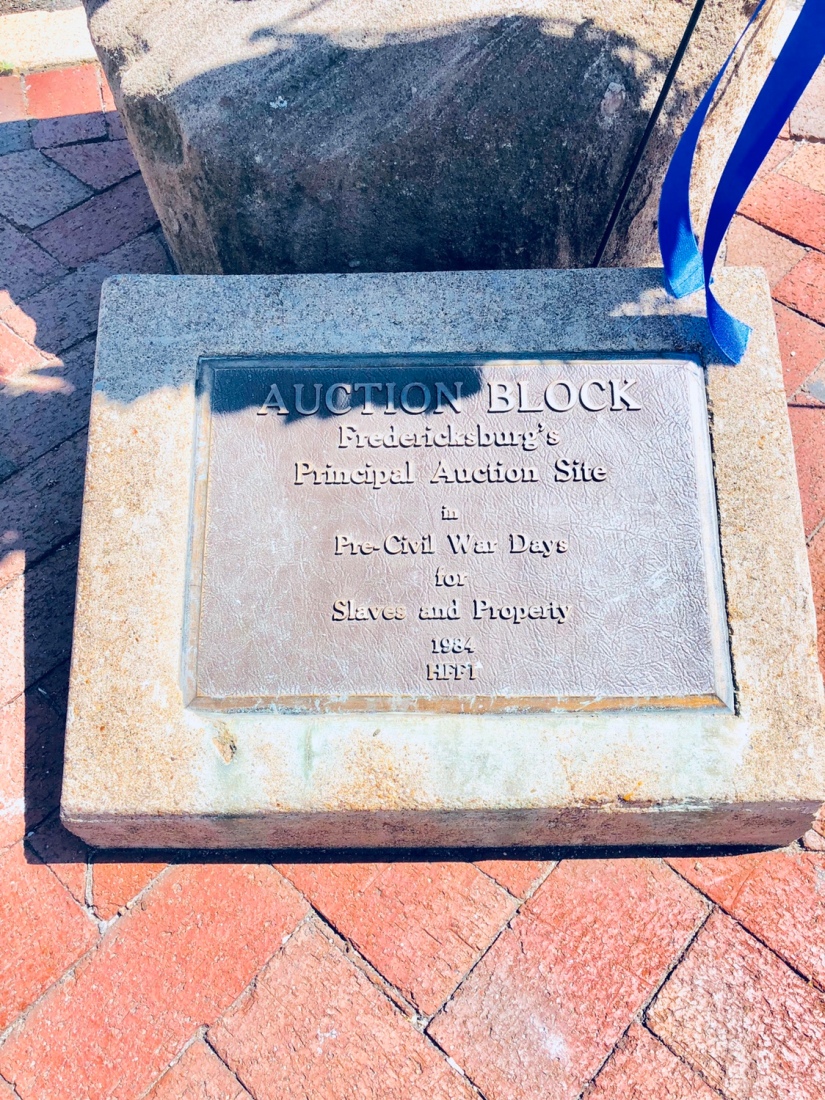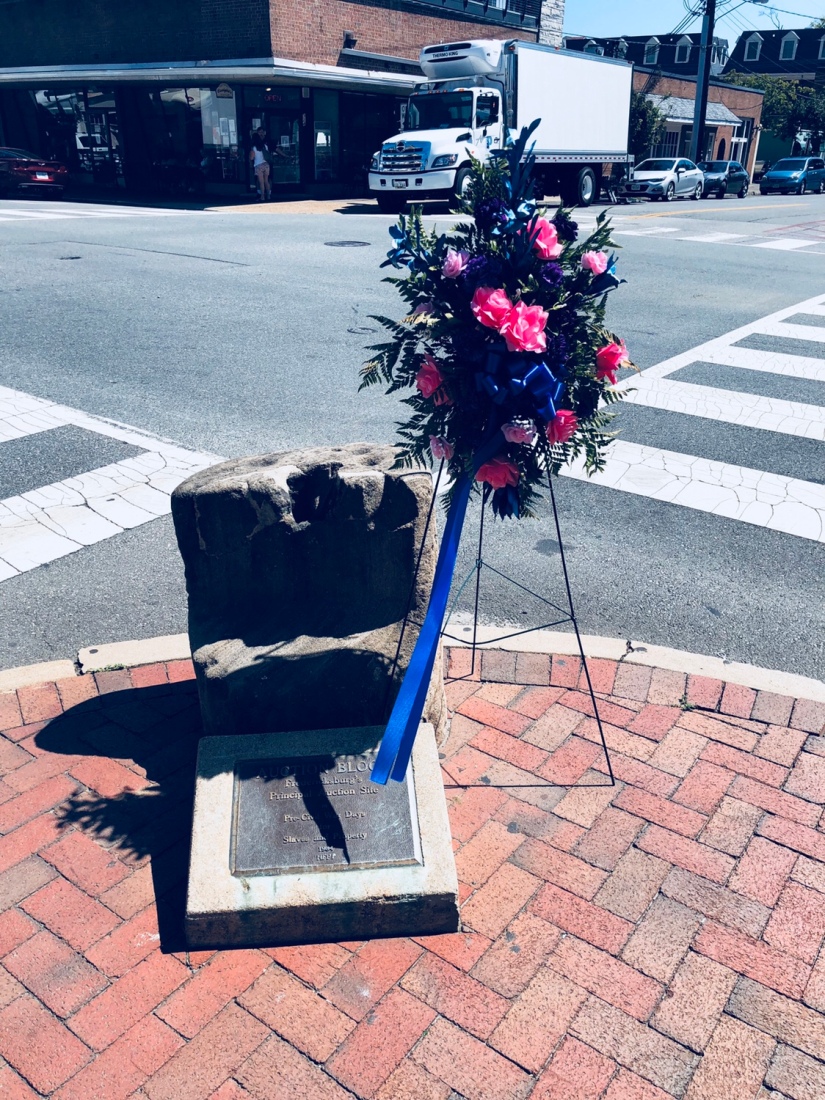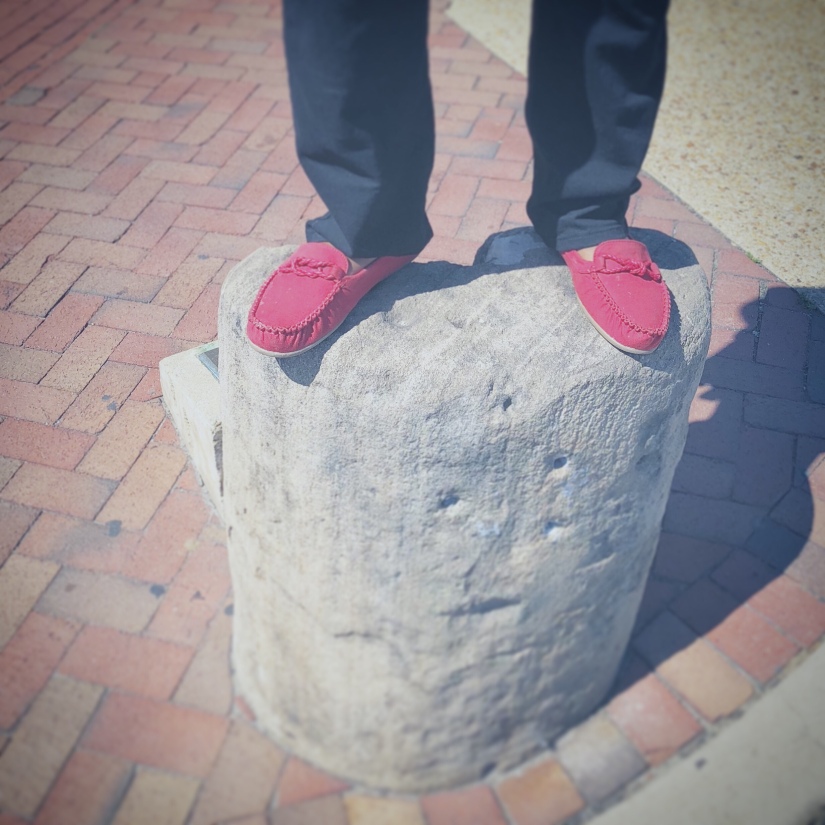In Fredericksburg, Virginia a slave auction block stands on the corner of one of the busiest streets of the historic downtown. When I moved to Fredericksburg in 2011, the plaque in front to the auction block was the first historical marker that I stopped to read. I thought it was a hitching post and I wondered what was so special about it. When I read that it was a slave auction block, I early fell over from grief.

You see, Virginia is my ancestral home. My first free direct ancestor (my paternal great grandmother, Lucy) was born in Spotsylvania County (Fredericksburg was part of Spotsy until it became an independent city). My blood was bought and sold on Virginia soil, if not on that very auction block.
In Downtown Fredericksburg, the auction block blends into everyday life. People walk and drive past it without giving a second glance. It blends into everyday life as most of the history in the area does.

When I first moved to Virginia, I didn’t know how to deal with being surrounded by American history everywhere I went. People walk their dogs through acres of land where men lost their limbs and bodies were piled knee high. They hang out and buy their meat where people were sold as chattel. They have barbecues a few yards from where George Washington’s mom is buried. Major thoroughfares and schools are named after men who fought to keep people who look like me in chains. Plantations where slaves were abused and raped have become places of family fun, wedding venues, and places to get artsy pictures done. History blends into the mundane. It is simultaneously interesting and sickening.
When I lived in Virginia, I often wondered about the places where I walked. What did it look like when my ancestors lived there? Did they live on the land on which I walked and drove? If they walked in the same places that I did, how were they treated? I often felt ill when I thought of how people who looked like me were treated in some of the places I entered. I wondered if they were even allowed in the buildings that I freely entered and departed.
Once, when family came to visit, we went on a tour of Downtown Fredericksburg. I don’t know if it was part of the tour, but the tour guide made a point to share about how slaves and free black people were treated. Where they were and weren’t allowed. She even shared a few facts from the civil rights movement. My daughter (who was a baby at the time) and I were the only black people on the tour. I vacillated between feeling thankful that my history was being included and feeling othered because every time she said anything about black people, she looked and gestured toward me.
History is a cocktail of truth and deception. We rely on history to know what was, yet it can so easily be manipulated into what we want it to be. I once heard someone say that history remembers better than it lived. If that is true, then what depths of horror have been buried by the shame of those in power and the fear of those who were oppressed?
Living in a place that is steeped in history means living with the lies that our forebears told themselves and the lies that have been handed down to explain and protect the original set of lies. When such lies are attached to power and oppression, those in power must keep lying to themselves about what they did to get there, and those in power must also lie to the oppressed about themselves so that they will accept their oppression and be too afraid to fight back.
Those in power use history to retain their power by attempting to show themselves as the victors, the ones who are simply enjoying the fruit of their exceptionalism. They build monuments to themselves and they leave reminders for those who are being oppressed of who is in charge. Those reminders become part of everyday life to those who are in power (until you try to challenge or change them).
When the past becomes something that those in power pretend to be are no longer proud of, the reminders are rebranded as a ‘never forget’ so that those who have come to feel guilty about the past can sing rhapsodies about their guilt while maintaining their power and privilege. Those in power claim that they need the monuments and reminders so that they don’t forget how to act like decent human beings.
Even when the desire to learn from the past is genuine, the drive to ‘never forget’ centers the needs of the dominant group over (and sometimes against) the needs and desires of those who have never had a positive relationship with the items in question. People make the idealistic argument that keeping monuments and reminders around will cause people to reflect on the past, but, in reality, they only legitimize past wrongdoing and serve as a rallying point for people who dont’ feel guilty about the past.
The dynamics of power, guilt, and oppression are why I believe that the slave auction block and other reminders of slavery and the Civil War can be found throughout the South. They began as subtle reminders to the formerly enslaved of white power, but through the generations they have been recast as attitudes and social mores changed. Those in the dominant culture try to dictate to the historically marginalized how they should feel about these reminders, whether it’s shouting about ‘revisionist history’ or waxing poetic about ‘needing these reminders so that it never happens again.’
At the end of the day, its nothing but white people ignoring and continuing to strip agency from black folks. Wanting to keep monuments and reminders around so that ‘we never forget’ (as if libraries, history books, and museums aren’t a thing) is just as problematic as keeping them around to fight ‘revisionist history.’ Why is white education always founded on others’ pain?
While I don’t presume to speak for the black community in Fredericksburg (I did not grow up there and no longer live there), I can say that as someone who lived in the midst of the history and who is a daughter of the region, I find the auction block repulsive. While some people might take note of it and feel a twinge of sadness or guilt, I see the vast majority of people crossing the intersection at William & Charles unaffected by it.
For me, the auction block isn’t something to wax poetic and reflective about. I don’t need a reminder that slavery was a thing because I can see it when I look in the mirror every day. I can see it everywhere. You can too, if you open your eyes.
On September 6, 2018, I took the step of reclaiming and redeeming my history. On that sunny afternoon, I stood on the auction block with my fist raised in prophetic witness that black lives matter. I stood in prophetic witness that the very thing that meant to kill me will be my victory. Where my ancestors stood in shame, I stand in dignity. I know that my Redeemer lives.

As I stood on the block, people on the street and in their cars drove by and stared. I could see surprise and even confusion on many faces. One woman drove by and shook her head in disapproval. A small group of people seemed entertained, and even chuckled at first when they came upon me.

As I stood on the block, my face set like stone, I felt a wave of emotion. Sorrow, fear, anger, humiliation.
But then something flipped, and I felt a wave of strength and defiance come over me. This is the river of shame that runs through my past, but it is not my future.

My ancestors’ heels were bruised by white supremacy, but my feet will crush its head.



Thank you for this witness.
LikeLike
Thank you for your commentary, Ally. I don’t know how I found my way to your content, but I’m enjoying it.
LikeLike